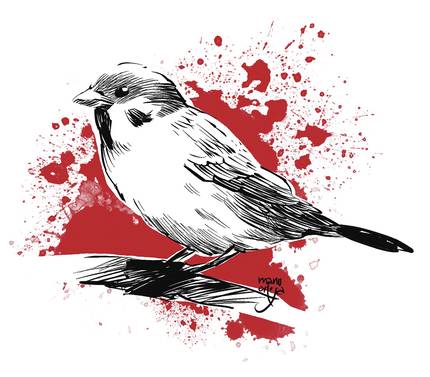Against a wrong enemy
“The battle began in the early morning of December 13 throughout the city. On the big and small streets, the red flags fluttered. The heights of the buildings and patios, the open spaces, the roads and the field fields were stitched with sentinels, students, officials, factory workers, peasants and members of the People’s Liberation Army, all of them crying out for war.” So he picked up a newspaper from Shanghai in 1958, the chronicle of that bloody day.
“Half of the workforce was mobilized in the city and suburbs,” the chronicle continues. “The factories committed themselves to a war effort that would ensure the maintenance of the productive level... In this way, the citizens fought against txolarrea.”
The war had begun a few months earlier. The Time journal received the following information in May of that year: “At five o’clock in the morning, turtles, jokes and whistles were heard. The students touched the kitchen utensils and sang a revolutionary and passionate hymn: “Rise up, oh, with just one million hearts! Defying enemy fire, go ahead!”
“According to the latest report, 310,000 Gorrions fell in Beijing alone and 4 million are estimated across China.” Tim's article also cited a national hero: This is Yang Seh-mun, 16 years old and native to Yunnan. An estimated 20,000 people died in the Caribbean country. “He found trees that were nesting during the day and, at night, he would climb the trees and choke whole families with his hands.”
All that was a higher order plan, that of Mao Zedong, the boss. He made it clear: “Gorrions are one of China’s worst pests. They are enemies of the revolution. They eat our crops. Flush them out. No warrior will retire until his disappearance.”
In order to transform China, Mao had just launched the Great Leap to the Popular Front. Through socio-economic planning, he wanted to promote rapid industrialization in a country dominated by agriculture, to equate it to the more advanced countries. And one of the first actions of that planning was the Four Pests Campaign, which would eliminate flies, mosquitoes, rats and gorrions.
According to the Government, this was a public health act, as the pests were very dangerous. Mosquitoes, for example, transmitted malaria, rats transmitted bubonic plague and other diseases. And they had a big problem with these diseases.
The sin of the gorrions was to eat grain, vegetables and fruit. According to government estimates, each gorilla consumed about 4.5 kg of grain a year, so the death toll would be 60,000 more.
They did a big ad campaign. And millions of Chinese gorrions began to die. They destroyed the nests, shot them, threw them with tyrons and poisoned them (sparrows and gorrions). And one of the most effective methods was uproar. Playing sarthenes or drums, screaming, flying red flags, etc., it was about frightening the gorrions so they wouldn't stop flying. And because the effort to fly was so great that they couldn't stand, they suddenly fell through the air, and they fell to thousands.
Gorrions found refuge in diplomatic missions. The Polish embassy, for example, refused to allow people to go in to scare the Gorrions. Then the embassy was surrounded by several tamborilers. For two days, without interruption, they played the drum. The Poles had to hit the dead bodies of the Gorrions.
They weren't very successful with rats, flies and mosquitoes, but they did with gorrions. They almost disappeared.
The next year, insects, especially lobsters, destroyed much of the harvest.
When the Four Pests Campaign was announced, the Chinese Academy of Sciences tried to warn that the elimination of gorrions might not be a good idea. Ornithologist Tso-hsin Cheng argued that serious analyses were needed, at least, before such harsh destruction policies were put in place.
Chenge insisted on the government to review the entry of the Gorrions into the Four Pests campaign, but it was useless. Mao refused to listen to the experts.
Cheng was declared a criminal, forced to wear a badge that said “reactionary”, had to do “re-education” work (facilitate soils, clean toilets, etc. ). ), he even remained in detention for some time. In addition, they carried out a study to demonstrate their knowledge of ornithology, asking them to identify a bird composed of fragments of different species. When he failed that test, he was reduced to the minimum wage.
However, Chenge, with a team of researchers, studied the contents of the stomachs of 800 gorrions across China and showed that although gorrions ate grain, they also ate many insects and were essential to control agricultural pests.
It was finally clear that the death of the gorrions (and with them many other birds) caused many insects to remain almost without predators and, consequently, to multiply.
Until Mao warned that the plan was not working properly. And in 1960 he ordered no more attack on the Gorrions. “Forget them,” saying.
But the damage was already done. And in addition, insect pests were associated with other factors: drought, the abandonment of many farmers from land and emigration to industry, etc. Harvests became tremendously small and had serious consequences: From 1959 to 1961, he was one of the largest hungry in history in China. Between 15 and 45 million people died.
In 1961, the government secretly imported 250,000 gorrions from Russia.
At present, the population of gorrions that existed before the massacre has not been recovered.
Since 2001, it is a protected species and it is forbidden to kill, eat and sell, as well as being a criminal offence to have more than 20 deaths.







